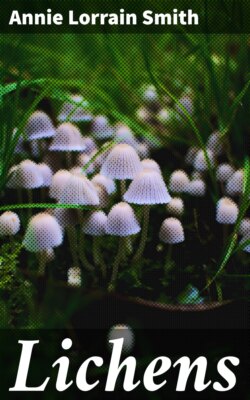Читать книгу Lichens - Annie Lorrain Smith - Страница 57
На сайте Литреса книга снята с продажи.
2. SQUAMULOSE LICHENS A. Development of the Squamule
ОглавлениеThe crustaceous thallus is more or less firmly adherent to, or confused with, the substratum. Further advance to a new type of thallus is made when certain hyphal cells of soredium or granule take the lead in an ascending direction both upwards and outwards. As growth becomes definitely apical or one-sided, the structure rises free from the substratum, and small lobules or leaflet-like squamules are formed. Each squamule in this type of thallus is distinct in origin and not merely the branch of a larger whole.
In a few lichens the advance from the crustaceous to the squamulose structure is very slight. The granules seem but to have been flattened out at one side, and raised into minute rounded projections such as those that compose the thallus of Lecanora badia generally described as “subsquamulose.” The squamulose formation is more pronounced in Lecidea ostreata, and in some species of Pannaria; and the whole thallus may finally consist of small separate lobes as in Lecidea lurida, Lecanora crassa, L. saxicola, species of Dermatocarpon and the primary thallus of the Cladoniae. Most of these squamules are of a firm texture and more or less round in outline; in some species of Cladonia, etc., they are variously crenate, or cut into pinnate-like leaflets. Squamulose lichens grow mostly on rocks or soil, occasionally on dead wood, and are generally attached by single rhizoidal hyphae, either produced at all points of the under surface, or from the base only, growth in the latter case being one-sided. In a few instances, as in Heppia Guepini, there is a central hold-fast.
A frequent type of squamulose thallus is that termed “placodioid,” or “effigurate,” in which the squamulose character is chiefly apparent at the circumference. The thallus is more or less orbicular in outline; the centre may be squamulose or granular and cracked into areolae; the outer edge is composed of radiating lobules closely appressed to the substratum (Fig. 42).
Fig. 42. Placodium murorum DC. Part of placodioid thallus with apothecia × 2.
All lichens with this type of thallus were at one time included in the genus Placodium, now restricted by some lichenologists to squamulose or crustaceous species with polarilocular spores. Many of them rival Xanthoria parietina in their brilliant yellow colouring.
Fig. 43. Lecania candicans A. Zahlbr., with placodioid thallus, reduced (S. H., Photo.).
There are also greyish-white effigurate lichens such as Lecanora saxicola, Lecania candicans (Fig. 43) and Buellia canescens, well-known British species.
